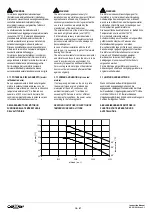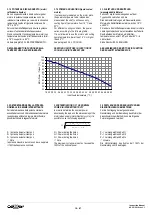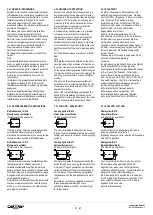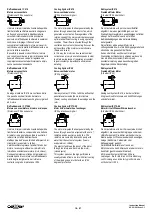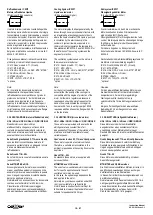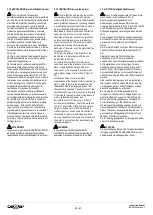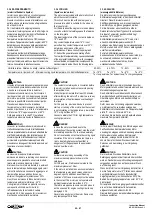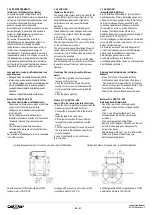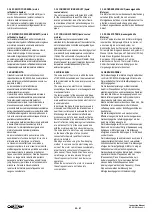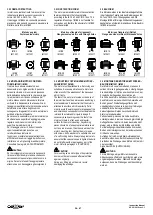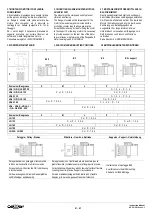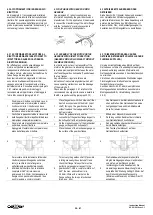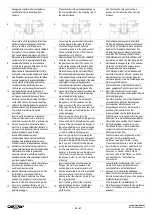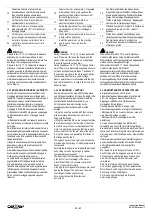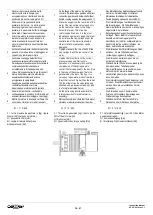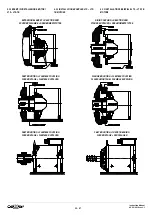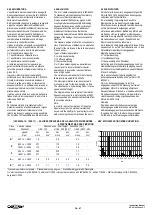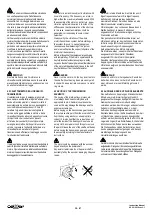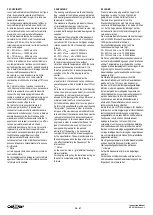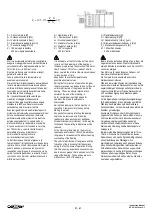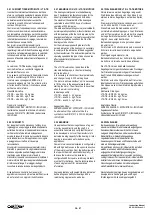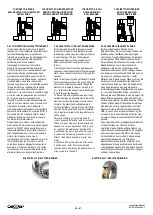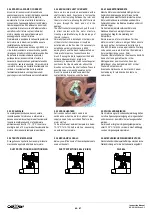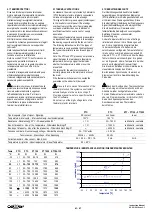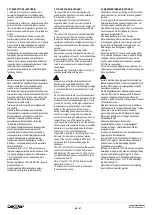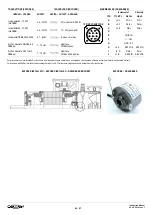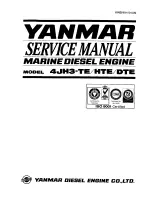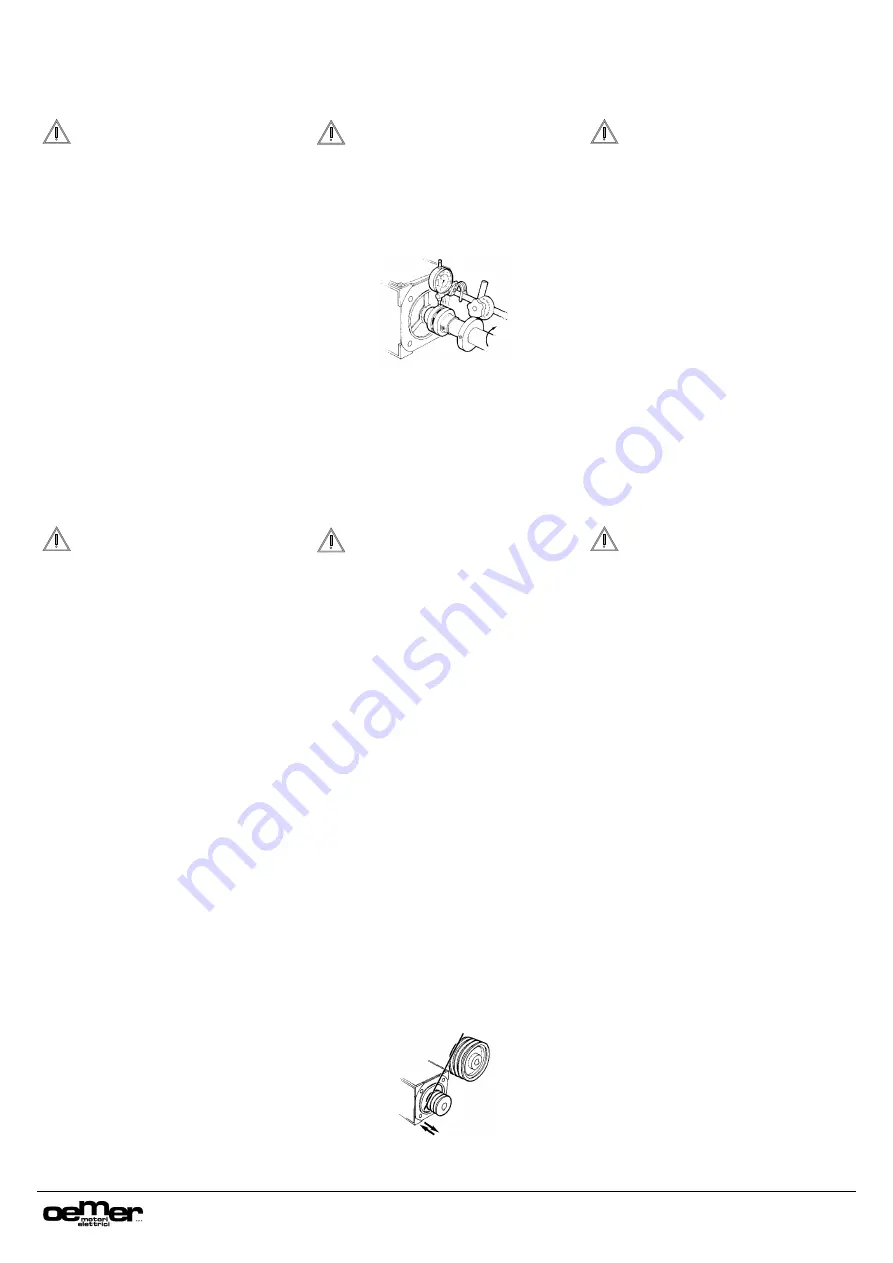
28 - 97
Instruction Manual
AC 02/2019-rev.1.1
4.0 ACCOPPIAMENTI
La trasmissione del moto rotatorio alla macchina
può essere effettuata mediante accoppiamento
diretto oppure con cinghie o ingranaggi.
ATTENZIONE
Verificare che gli organi di trasmissione scelti siano in
grado di trasmettere la coppia max. erogabile dal
motore e sopportare la massima velocità di
funzionamento prescelta. Il dimensionamento deve
essere effettuato con ampio margine per quanto
riguarda gli aspetti sopra elencati
4.0 COUPLING
The transmission of the rotation movement to the
machine can be obtained through direct coupling
or through belts or gears.
WARNING
Verify that the chosen transmission
components are capable of discharging the
max motor available torque and withstand the
maximum chosen speed. The dimensioning
must be calculated with ample margins for the
above mentioned aspects.
4.0 VERBINDUNGEN
Die Übertragung der Drehbewegung der
Arbeitsmaschine kann über direkte Kupplung, durch
Riemen oder Zahnräder erfolgen.
WARNUNG
Stellen Sie sicher, dass die ausgewählte Verbindungsart
geeignet ist, das höchste Drehmoment des Motors zu
übertragen und der gewählten maximalen
Betriebsgeschwindigkeit standhält. Die Bemessung muß
einen großzügigen Spielraum bezüglich der
obengenannten Aspekte vorsehen.
4.1 ACCOPPIAMENTO DIRETTO
Utilizzare un giunto elastico che eviti la trasmissione
di spinte assiali ai cuscinetti e che compensi
eventuali errori di allineamento tra gli alberi di
trasmissione. Nel caso di accoppiamento diretto
(albero innestato) è assolutamente indispensabile
effettuare un esatto allineamento fra albero motore e
albero condotto e fra le flange di accoppiamento.
Eventuali vibrazioni ed irregolarità di rotazione
sono indizio di allineamenti imprecisi che
causano anomalie di funzionamento e rottura
dell’albero motore. In ogni caso, data l’incertezza
di accoppiamento e la scarsa affidabilità,
r
icorrere all’accoppiamento diretto (albero
innestato) solo nei casi in cui non sia possibile la
trasmissione del moto tramite giunti o pulegge.
4.1 DIRECT COUPLING
Use a flexible joint that does not transmit axial
thrust to the bearings and that compensates for
possible alignment errors between the transmission
shafts. In the case of direct coupling (engaged-
shaft) take the utmost care to make a precise
alignment between the motor shaft and the driven-
shaft and between the coupling flanges.
Any vibrations or irregular rotations are
indications of inaccurate alignments which will
cause operating malfunctions and the breakage
of the motor shaft. However, owing to the
difficulty of accurate coupling and its associated
reliability, only make use of direct coupling
(engaged shaft) in cases where transmission by
means of joints and pulleys is not possible.
4.1 DIREKTER ANBAU
Es ist ein elastische Kupplung zu verwenden,
um axiale Kräfte auf die Lager und eventuelle
Fluchtungfehler der Wellen zu vermeiden. Bei
direkter Verbindung (ohne Kupplung) ist es
unbedingt erforderlich, dass eine exakte
Fluchtung zwischen der Eintriebs- und
Abtriebswelle ausgeführt wird.
Mögliche Vibrationen und Drehunregelmäßigkeiten sind
Zeichen ungenauer Fluchtung, welche
Funktionsstörungen und den Bruch der Antriebswelle
verursachen können. Aufgrund der genannten
Porbleme dieser Verbindung und der geringen
Zuverlässigkeit sollte nur in jenen Fällen darauf
zurückgegriffen werden, in denen Kupplungen oder
Riemenabtriebe nicht möglich ist
4.2 ACCOPPIAMENTO CON CINGHIE
Installare il motore con l’albero perfettamen
te
parallelo ed allineato a quello della puleggia per
evitare spinte assiali sui supporti.
Il tiro delle cinghie deve essere sufficiente ad
evitare lo slittamento nel funzionamento del
motore a pieno carico e comunque non deve
superare in nessun caso il carico massimo
applicabile e riportato sul catalogo tecnico. Una
tensione eccessiva delle cinghie può provocare
un rapido logorio dei cuscinetti ed anche la
rottura dell’albero.
Per le velocità periferiche delle cinghie, potenze
trasmesse, rapporti tra diametri delle pulegge
etc., consultare il catalogo del fornitore delle
cinghie. Utilizzare sempre pulegge equilibrate.
Vedi paragrafo 4.4 (equilibratura).
Per il calcolo del diametro minimo della puleggia,
la potenza trasmissibile ed il carico sull’albero
consultare il paragrafo 5.0.
4.2 COUPLING WITH DRIVE BELTS
Install the motor with the shaft perfectly
parallel and aligned to that of the pulley in
order to avoid axial thrust on the supports.
The tensioning of the belts must be sufficient
to prevent the slipping when the motor is
running at full-load capacity but in no case
must it exceed the maximum applicable load
described in the technical catalogue.
Excessive tension of the belts can cause
rapid wear of the bearings and may even
cause shaft breakages. For peripheral speeds
of the belts, transmitted power, ratios between
the pulley diameters etc. consult the tachnical
data supplied by the belt manufacturer.
Always use balanced pulleys. Refer to
paragraph 4.4 (balancing).
For the pulley minimum diameter calculation,
the transmissible power and the load on the
motor shaft see the paragraph 5.0
4.2 RIEMENANTRIEBE
Den Motor mit der parallelen auf die
Riemenscheibenwelle ausgerichteten Antriebswelle
installieren, um Achsenlängsschübe auf den Lagern
zu vermeiden. Die Riemen müssen fest genug
gespannt sein, um einen Riemenschlupf bei voller
Motorleistung zu vermeiden. Auf keinen Fall darf die
im technischen Katalog wiedergegebene,
anwendbare Grenzbelastung überstiegen werden.
Eine übermäßige Spannung der Riemen kann einen
raschen Verschleiß der Lager und sogar den Bruch
der Welle verursachen.
Über die Umfangsgeschwindigkeiten der Riemen, die
übertragenen Leistungen, die Verhältnisse der
Riemenscheibendurchmesser usw. Ist im Katalog über
Riemen nachzulesen. Stets ausgewuchtete Riemen
benutzen. Siehe Abschnitt 4.4 (Auswuchtung).
Für die Berechnung des minimalen Riemenscheiben-
durchmessers und der Achsbelastung siehe Abschnitt
5.0.

